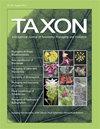Phylogeny of Berberidopsidales based on nuclear and chloroplast loci, with the description of a new species of Berberidopsis endemic to Central Chile
IF 2
2区 生物学
Q2 EVOLUTIONARY BIOLOGY
引用次数: 0
Abstract
Berberidopsidales comprises two families: monotypic Aextoxicaceae (基于核基因位点和叶绿体基因位点的小檗目植物系统发育,并描述智利中部特有的一个小檗新种
小檗科包括两个科:单型的 Aextoxicaceae(智利和阿根廷的 Aextoxicon punctatum)和 Berberidopsidaceae。后者包括澳大利亚的单型 Streptothamnus(S. moorei)和 Berberidopsis(澳大利亚的 B. beckleri 和智利的 B. corallina)。本文描述了一个来自智利安第斯山脉中部的 Berberidopsis 新种。基于核和叶绿体数据的系统发育分析明确了拟小檗属(Berberidopsidales)内部的关系。新种 Berberidopsis granitica 是智利特有种 B. corallina 的姊妹种,该支系与澳大利亚的 B. beckleri 是姊妹支系。根据分子系统发育的年代,南美洲B. corallina和B. granitica之间的分裂发生在中新世晚期/更新世早期,而南美洲和澳大利亚Berberidopsis之间的分裂发生在中新世晚期和上新世,这表明它们是越洋扩散而不是沧海桑田。气候生态位分析表明,澳大利亚和南美洲南部的物种有两个不同的、不重叠的气候生态位。Berberidopsis granitica和B. corallina除了气候生态位不同外,在栖息地和形态上也有明显差异。Berberidopsis granitica 的分布区域非常有限,生长在安第斯山脉的山地气候条件下,在 Berberidopsidales 中独一无二。
本文章由计算机程序翻译,如有差异,请以英文原文为准。
求助全文
约1分钟内获得全文
求助全文
来源期刊

Taxon
生物-进化生物学
CiteScore
4.70
自引率
8.80%
发文量
177
审稿时长
6-12 weeks
期刊介绍:
TAXON is the bi-monthly journal of the International Association for Plant Taxonomy and is devoted to systematic and evolutionary biology with emphasis on plants and fungi. It is published bimonthly by the International Bureau for Plant Taxonomy and Nomenclature, c/o Institute of Botany, Slovak Academy of Sciences, Dúbravská cesta 9, SK-845 23 Bratislava, SLOVAKIA. Details of page charges are given in the Guidelines for authors. Papers will be reviewed by at least two specialists.
 求助内容:
求助内容: 应助结果提醒方式:
应助结果提醒方式:


